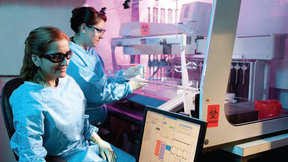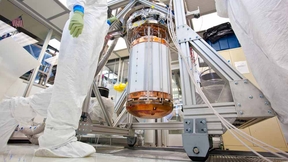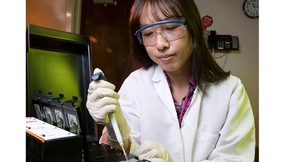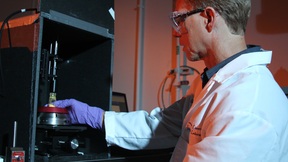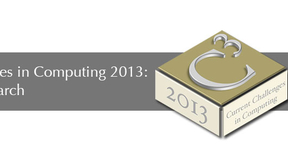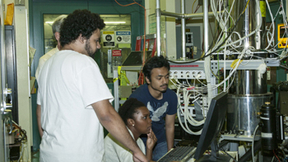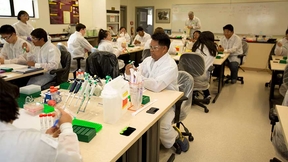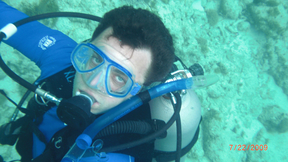Back
LIVERMORE, Calif. -- Two Lawrence Livermore National Laboratory scientists have been selected as 2013 fellows of the American Physical Society (APS).John Moody, acting group leader for hohlraum energetics/optical diagnostics in the Inertial Confinement Fusion Program, was cited in the plasma physics category for "pioneering experiments contributing to understanding…
Lawrence Livermore National Laboratory (LLNL) has again received recognition this year for its work to move breakthrough technologies into the commercial marketplace.Livermore researchers and tech transfer professionals garnered four awards in the Federal Laboratory Consortium's (FLC) Far West Regional competition.This year's awards, presented last week during the FLC's…
LEAD, S.D. - After its first run of more than three months, operating a mile underground in the Black Hills of South Dakota, a new experiment named LUX has proven itself the most sensitive dark matter detector in the world."LUX is blazing the path to illuminate the nature of dark matter," says Brown University physicist Rick Gaitskell, co-spokesperson for LUX with…
Over the last 50 years, scientists from Lawrence Livermore National Laboratory's (LLNL) Biosciences and Biotechnology Division (BBTD) have changed the world by being instrumental researchers on the Human Genome Project, developing high-tech devices to sort cells and analyze DNA and providing the science for federal programs to defend the nation from biological weapons…
The Royal Swedish Academy of Sciences awarded the Nobel Prize in physics today to theorists Peter Higgs and Francois Englert to recognize their work developing the theory of what is now known as the Higgs field, which gives elementary particles mass.U.S. scientists, including researchers at Lawrence Livermore National Laboratory (LLNL), played a significant role in…
A team of Lawrence Livermore National Laboratory (LLNL) researchers has pioneered the use of a long-standing technology for a new application -- analyzing the chemical composition of uranium samples.In a paper published as the cover story in the September edition of Applied Spectroscopy , the Laboratory scientists describe the first reported use of near-infrared…
The latest generation of high performance computers has the potential to transform the biomedical field in ways unthinkable just a few years ago.That was the theme that emerged from the "Current Challenges in Computing 2013: Biomedical Research" conference, or CCubed, held earlier this month in Napa. Sponsored by IBM with support from the Laboratory, the meeting brought…
Jim Hammer, a physicist in the Weapons and Complex Integration Directorate (WCI) at Lawrence Livermore National Laboratory, is a recipient of the 2013 Edward Teller Medal.The Fusion Energy Division of the American Nuclear Society (ANS) presented the award recently during the International Inertial Fusion Science Applications (IFSA) conference in Nara, Japan. Hammer was…
Three students from Historically Black Colleges and Universities (HBCUs) participated in a two-week plasma physics summer school at Lawrence Livermore National Laboratory (LLNL). The course, "Introduction to the Analysis of Spectra from High-Temperature Plasmas," was a concentrated introduction to the study of astrophysical plasmas, magnetic fusion plasmas and laser…
A group of international scientists including a Lawrence Livermore National Laboratory researcher have confirmed that life really could have come from out of this world.The team shock compressed an icy mixture, similar to what is found in comets, which then created a number of amino acids - the building blocks of life. The research appears in advanced online publication…
Researchers from Lawrence Livermore National Laboratory (LLNL) and Florida-based Chemergy Inc. plan to demonstrate an innovative bioenergy technology that converts wastewater treatment plant byproducts into hydrogen gas to produce electricity. The $1.75 million project will demonstrate an integrated system on a limited industrial scale at the Delta Diablo Sanitation…
A Lawrence Livermore National Laboratory (LLNL)-developed biological detection technology has been employed as part of an international collaboration that has detected a virus in bladder cancers.The research, performed in conjunction with scientists from the University of Split in Croatia, LLNL and the University of Jordan in Amman is believed to be the first study to…
A recently discovered mineral appears to be clear but may have a tinge of light blue. No matter its color, you won't be able to make earrings from it.For one, you can't see the material with the naked eye. Hutcheonite, recently named after Lawrence Livermore meteorite researcher Ian Hutcheon, can be seen only with high powered scanning electron microscopes.Known also by…
Outbreaks such as the severe acute respiratory syndrome (SARS) and Middle East respiratory syndrome coronavirus (MERS) have afflicted people around the world, yet many people think these trends are on the decline.Quite the opposite is true.The efforts to combat this epidemic are being spearheaded by a team of Lawrence Livermore National Laboratory (LLNL) scientists. Led by…
Iron is the most abundant element in Earth's core and the sixth most abundant element in the universe. As a key component of terrestrial planets and exoplanets, iron has been one of the most studied materials under extreme conditions.In a series of campaigns led by the Lab's Yuan Ping using the OMEGA laser at the Laboratory for Laser Energetics (LLE) at the University of…
One of the keys to commercialization of advanced biofuels is the development of cost-competitive ways to extract fermentable sugars from lignocellulosic biomass. The use of enzymes from thermophiles -- microbes that thrive at extremely high temperatures and alkaline conditions -- holds promise for achieving this development. Finding the most effective of these microbial…
From developing the first accelerator mass spectrometer for use in the biology field to tracking radionuclides from the Dai-ichi Nuclear Power Plant disaster, the Laboratory's Center for Accelerator Mass Spectrometry (CAMS) has spent 25 years in the spotlight of not only dating ancient artifacts but solving global challenges.CAMS is celebrating its 25th anniversary this…
Research conducted at the Center for Accelerator Mass Spectrometry (CAMS) spans the universe, the depths of time and everything in between. Although not all elements and isotopes are able to be utilized by AMS, CAMS' researchers make the most of what nuclear physics has given them.Here is a sampling of some of the many ways CAMS is utilized, along with the important…
LIVERMORE, Calif., - California and Hawaii teachers seeking real-world knowledge to teach biotech and computational modeling are attending the Lawrence Livermore National Laboratory's (LLNL) Teacher Research Academy that began on July 22.The academy is a summer-long series of professional development workshops for teachers and enrichment programs for students. The programs…
When Lawrence Livermore National Laboratory physicist Maxim Umansky flipped through the news, a startling underwater survival story caught his attention. In May, a boat cook survived a 60-hour underwater ordeal 100 feet below the surface after his tugboat sank near the Nigerian coast.Harrison Okene's survival underwater while the rest of the crew perished was astounding…


